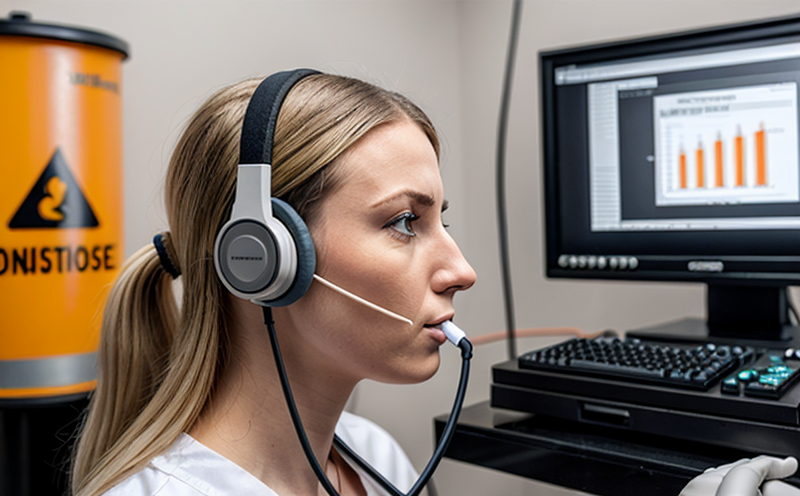ISO 11204 Noise Emission Testing with Sound Intensity Method
The ISO 11204 Noise Emission Testing with Sound Intensity Method is a critical standard for assessing noise emissions from various sources, including machinery, equipment, and facilities. This method offers a precise approach to quantify sound pressure levels at specific points in space without the need for anechoic chambers or other restrictive environments.
The process involves measuring the intensity of sound waves using specialized probes that provide accurate data on the spatial distribution of noise. This non-invasive technique is particularly useful in evaluating noise from complex sources where traditional methods may not yield reliable results. The test setup includes calibrated sound intensity probes, which are positioned strategically to capture the sound field.
The procedure follows a structured approach: first, the noise source is identified and characterized; second, the probe positions are determined based on the geometry of the source and the environment in which it operates; third, the intensity measurements are taken at each point; finally, the data is processed to determine compliance with relevant standards or regulatory requirements.
The sound intensity method provides a comprehensive analysis by measuring both sound pressure and particle velocity simultaneously. This dual measurement approach ensures that any reflections or obstructions in the test environment do not distort the results. The standard specifies detailed acceptance criteria, which include permissible noise levels and spatial coverage requirements.
The importance of this testing cannot be overstated, especially in industries where occupational noise exposure is a significant concern. By accurately quantifying sound emissions, employers can ensure compliance with health and safety regulations while also protecting employees' hearing and overall well-being.
For machinery manufacturers, this test method helps identify potential design improvements to reduce noise levels, thereby enhancing the product's marketability and reducing warranty claims related to noise complaints. In facilities management, it ensures that new constructions meet regulatory requirements for acceptable noise levels in public spaces or industrial zones.
The application of ISO 11204 is not limited to specific industries but spans across sectors where machinery and equipment are used extensively. From manufacturing plants to construction sites, airports to healthcare facilities, the sound intensity method provides a versatile tool for evaluating noise emissions effectively.
| Applied Standards |
|---|
| ISO 11204: Acoustics — Sound intensity measurement technique and associated reference conditions |
The standard is widely recognized for its accuracy and reliability, making it a preferred choice in many industries. The method's ability to capture detailed spatial information about the sound field makes it particularly valuable for complex noise sources.
Why It Matters
Occupational noise exposure can lead to significant health risks, including hearing loss and stress-related disorders. According to the World Health Organization (WHO), approximately 16% of the global burden of disease is attributed to occupational risk factors. Ensuring compliance with ISO 11204 not only protects workers' health but also demonstrates a commitment to corporate social responsibility.
The sound intensity method provides a robust framework for monitoring and controlling noise emissions, which can help prevent these risks. By identifying noise sources and quantifying their impact accurately, employers can implement targeted mitigation strategies to reduce exposure levels. This proactive approach not only enhances worker safety but also contributes to the overall sustainability of operations.
Compliance with ISO 11204 is essential for facilities that must meet regulatory requirements or industry-specific standards. For instance, in manufacturing environments, noise levels above permissible limits can lead to fines and reputational damage. By adhering to this standard, companies ensure they are meeting these expectations and maintaining a safe work environment.
The method's ability to provide detailed spatial information is particularly beneficial for facilities with complex layouts or multiple noise sources. It allows for precise identification of high-risk areas and helps in making informed decisions about noise control measures. This approach ensures that resources are allocated effectively, leading to cost savings and improved operational efficiency.
Applied Standards
The ISO 11204 standard is supported by a range of other international standards that provide additional context and support for the testing process:
- ISO 9612:2018 — Noise in work environments, part 2: Measurement techniques
- ISO 3745:2016 — Acoustics — Determination of sound pressure levels at points in space and related quantities
- ASTM E90-18 — Standard test methods for measurement of noise generated by machinery using a sound intensity microphone array
The combination of these standards ensures comprehensive coverage of the testing process, providing a robust framework for accurate and consistent measurements.
Benefits
- Precise Measurement: The sound intensity method provides highly precise measurements by capturing both sound pressure and particle velocity simultaneously.
- No Environmental Restrictions: Unlike anechoic chambers, this method allows testing in real-world environments without the need for specialized conditions.
- Comprehensive Spatial Coverage: It offers detailed spatial information about noise distribution, which is essential for identifying high-risk areas.
- Regulatory Compliance: Ensures that facilities meet regulatory requirements and industry-specific standards for acceptable noise levels.
- Economic Efficiency: By providing accurate data, this method helps in the efficient allocation of resources for noise control measures.
- Enhanced Worker Safety: Identifying and quantifying noise sources helps protect workers from potential health risks associated with prolonged exposure to high noise levels.





